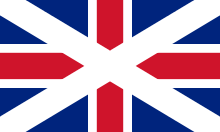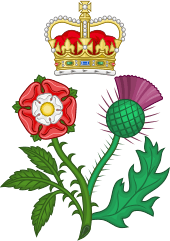Flag of Great Britain
The flag of Great Britain, commonly known as King's Colours, the Union Jack, or the British flag, was used at sea from 1606 and more generally from 1707 to 1801.[1][2]
.svg.png) | |
| Name | King's Colours |
|---|---|
| Use | Civil and state flag |
| Adopted | 1707 |
| Design | Four stripes of white, horizontal, diagonal, and vertical on a blue field, with a red cross in the middle. |
.svg.png) Variant flag of Great Britain | |
| Use | Civil and naval ensign |
| Design | A red field with the flag of Great Britain in the canton |
.svg.png) Variant flag of Great Britain | |
| Use | Naval ensign |
| Design | A cross of St George with the flag of Great Britain in the canton |
.svg.png) Variant flag of Great Britain | |
| Use | Naval ensign |
| Design | A blue field with the flag of Great Britain in the canton |
The design was ordered by King James VI and I to be used on ships on the high seas, and it subsequently came into use as a national flag following the Treaty of Union and Acts of Union 1707, gaining the status of "the Ensign armorial of Great Britain", the newly created state. It was later adopted by land forces, although the blue of the field used on land-based versions more closely resembled that of the blue of the flag of Scotland.
The flag consists of the red cross of Saint George, patron saint of England, superimposed on the Saltire of Saint Andrew, patron saint of Scotland. Its correct proportions are 3:5.
The flag's official use came to an end in 1801 with the creation of the United Kingdom of Great Britain and Ireland. At that time Saint Patrick's Flag was added to the flag of Great Britain to create the present-day Union Flag.
Creation
By James I of England, King of Scots, Orders in Council, 1606:
By the King: Whereas, some differences hath arisen between Our subjects of South and North Britaine travelling by Seas, about the bearing of their Flagges: For the avoiding of all contentions hereafter. We have, with the advice of our Council, ordered: That from henceforth all our Subjects of this Isle and Kingdome of Great Britaine, and all our members thereof, shall beare in their main-toppe the Red Crosse, commonly called St. George’s Crosse, and the White Crosse, commonly called St. Andrew’s Crosse, joyned together according to the forme made by our heralds, and sent by Us to our Admerall to be published to our Subjects: and in their fore-toppe our Subjects of South Britaine shall weare the Red Crosse onely as they were wont, and our Subjects of North Britaine in their fore-toppe the White Crosse onely as they were accustomed.
 A replica of the early 17th century Godspeed flying the flags of Great Britain and the Kingdom of England
A replica of the early 17th century Godspeed flying the flags of Great Britain and the Kingdom of England The flag of England
The flag of England.svg.png) The flag of Scotland
The flag of Scotland
King James had the habit of referring to a "Kingdom of Great Britain", considering that it had been created by the Union of the Crowns. However, despite the personal union which he represented, in practice England and Scotland continued as separate kingdoms, each with its own parliament and laws, for another century. The Kingdom of Great Britain finally came into being in 1707.[3] The flag of the new Kingdom was formally chosen on 17 April 1707, two weeks before the Acts of Union of 1707 were to take effect. Sir Henry St George, Garter Principal King of Arms, had presented several possible designs to Queen Anne and the Privy Council.[4]
Scottish variant
The principal alternative for consideration was a version of the flag with the saltire of Saint Andrew lying on top of that of Saint George, called the "Scots union flag as said to be used by the Scots", but this was rejected.
See also
- List of English flags
- List of Scottish flags
- Protectorate Jack
- Union Flag
- List of flags of the United Kingdom
References
- "British Flags". Flaginstitute.org.
- "The Union Jack or The Union Flag?". Flaginstitute.org.
- Michael Lynch, The Oxford Companion to Scottish History (2001), p. 356
- Linda Colley, Taking Stock of Taking Liberties: A Personal View (British Library, 2009), p. 46

